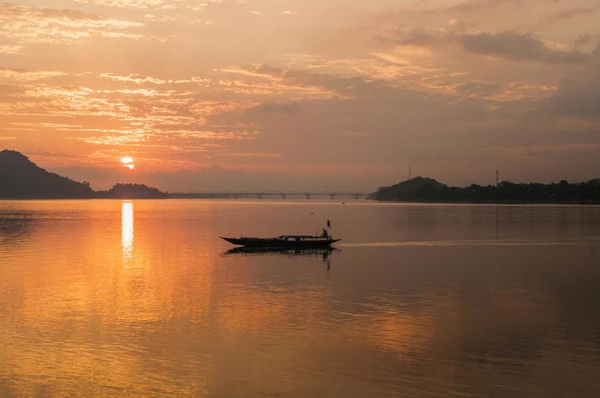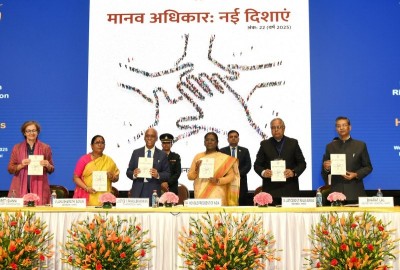
Lake formation or construction on Brahmaputra in Tibet : CWC, Assam govt fear huge damage in downstream
Guwahati, Apr 23 (IBNS): The Central Water Commission and the Assam government have sounded alerts ahead of the flooding season.
According to reports, people in Assam and Arunachal Pradesh fear that the three artificial lakes formed on the Yarlung-Tsangpo river in the Tibet region after intense earthquake activity in November 2017, are likely to create major disasters, such as landslides.
The Central Water Commission reported on the water quality of Siang river in Arunachal Pradesh saying that due to earthquake in Tibet (China) in November, 2017, landslides had occurred on the course of the river and in process there were blockage along the course of the river, which have in turn created artificial lake in the upstream.
The Central Water Commission also reported that, the surface area of the lake is about 10.22 hecta
The Water Resources Department of Assam government also reported that with the rainy season approaching, the risk of bursting of dams is growing, which may lead to a great disaster in Assam and Arunachal Pradesh.
A high level meeting was held in Guwahati on Monday in presence of top officials of Assam government, Central Water Commission, Brahmaputra Board, Assam State Disaster Management Authority (ASDMA).
Minister of External Affairs, Sushma Swaraj, who met her Chinese counterpart Wang Yi on April 22, ahead of the scheduled meeting between Prime Minister Narendra Modi and Chinese President Xi Jinping, said in a joint press conference that China has confirmed to share data on the Sutlej and Brahmaputra rivers.
“Earthquake has happened in Chinese territory with magnitude of nearly 6.4 and it has been reported by the concerned authority. Sudden landslides triggered by the earthquake might have been a reason. But the Government of India can’t say surely,” Abhay Kumar, Superintending Engineer of Central Water Commission, said.
On the other hand, Hemanta Narzary, Principal Secretary of Water Resources Department of Assam government said that, Monday’s meeting was held in direction of the higher authority to share the information on the formation of lake on the Yarlung-Tsangpo river in the Chinese territory.
“We were told that huge water is there and we thought that it is better to alert all linked departments. We have collected information from the Central Water Commission and NASA. We are alerting other departments also,” Hemanta Narzary said.
Arunachal Pradesh MP Ninong Ering had raised the issue of possible diversion of Siang river (Brahmaputra) by China in Tibet (Tsangpo river) and said he has also drawn Prime Minister Narendra Modi's attention to the same.
The Siang tributary of Brahmaputra turned muddy and slushy last year.
In a letter sent to the PM on February 7 last, Ering who represented the Arunachal East constituency said that, every year till April, the slow-melting glaciers and the Eastern Himalayan forests are the primary source of river water.
“During the monsoon months, rainfall carries sediments from the mountain slopes to the rivers and also causes dangerous landslides. In November, the monsoons turn weak and the rivers of Arunachal Pradesh turn blue. As the monsoon weakens, the river water clears up of their sediments and people can make use of water again,” Ering said in the letter.
However, owing to a powerful underwater earthquake in November, the likely formation of dams from debris may have taken place in the Yarlung Sangpo belt.
“However, 2017 was an exception. Intense earthquake activity in November 2017 triggered widespread landslides on the Yarlung-Tsangpo river (200 km upstream from Tuting). Three natural rockslide dams have formed on the river due to blockage by landslides and debris. It is only a matter of time before the natural dams burst and unleash a severe disaster along the Siang river valley. Satellite imagery by NASA and planet.com show that landslides of this size and danger level have not occurred on the Siang river for almost half a century. Complicating this issue further, between October 21 and October 27, 2017, an avalanche occurred on the Sendapu glacier which feeds into the Yarlung-Tsangpo,” Ering added.
The Arunachal Pradesh MP further said in his letter that, pools of water can be seen on the glacier surface, indicating that melting ice may have caused mud and rocks to slip.
“This avalanche was not triggered by earthquakes. This was the first indication of the Siang river being contaminated by natural reasons and matches with the first reports given in early November by the vigilant people of Arunachal Pradesh. The big M6.4 earthquake on Gyala Peri, and a series of earthquakes happened exactly 20 days later on the morning of November 17. The M6.4 that struck on November 17 was the largest and the shallowest earthquake since the year 1900 in that region. The high earthquake activity of the region is due to the Indian plate thrusting and squeezing against the Tibetan Plateau uplifting the Himalayas. Earthquake swarms have been reported from the area of the Yigong dam before and were behind the disaster on the Siang in year 2000. Earthquakes on the mountains Gyala Peri and Namcha Barwa have been rare events until now. The scale of the November landslides was so massive that just within 30 km of the river’s length, the mountain slopes have been stripped bare of forests and now are just mud and rock. Alarmingly, along 12 km of the river’s length, the landslides have partially blocked the river flow and have created three natural dams one behind the other,” Ering said in his letter.
Ninong Ering also urged the centre to take proactive and necessary steps to keep people of Arunachal Pradesh safe from this danger.
(Reporting by Hemanta Kumar Nath)
Support Our Journalism
We cannot do without you.. your contribution supports unbiased journalism
IBNS is not driven by any ism- not wokeism, not racism, not skewed secularism, not hyper right-wing or left liberal ideals, nor by any hardline religious beliefs or hyper nationalism. We want to serve you good old objective news, as they are. We do not judge or preach. We let people decide for themselves. We only try to present factual and well-sourced news.







